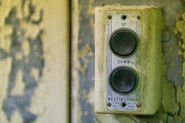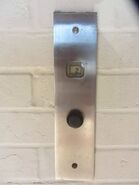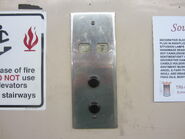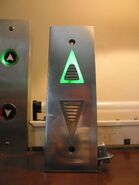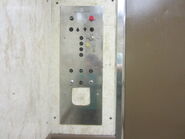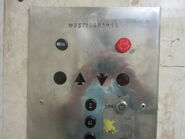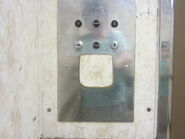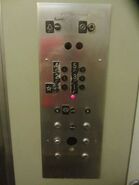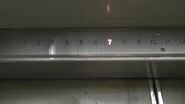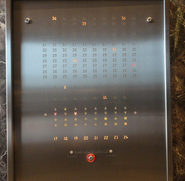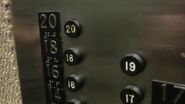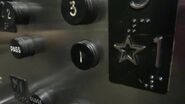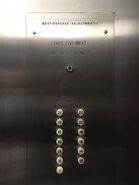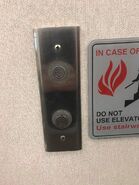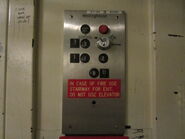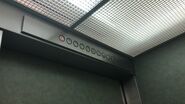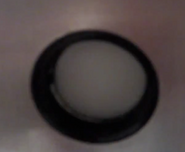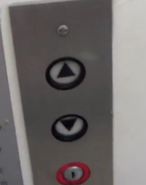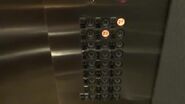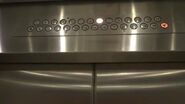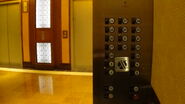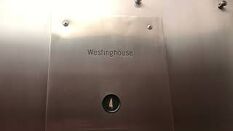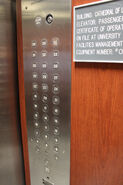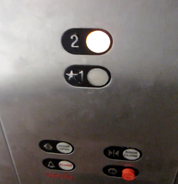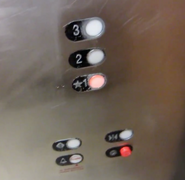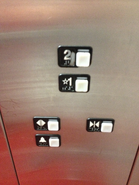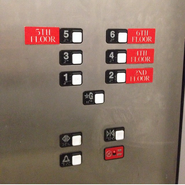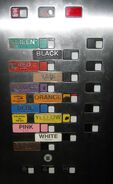This is a list of Westinghouse elevator fixtures. Westinghouse was a manufacturer of many different products, including elevators and escalators. Westinghouse started making elevators and escalators in the early/mid-1900's, and sold off their elevator division to Schindler in 1989.
This page lists elevator fixtures that were used in Westinghouse elevators in the United States and also Europe (France, Belgium and Germany).
1920s
Manually controlled
Westinghouse Electric Co. started elevator construction in 1928 with their first manually controlled systems being installed. Some Westinghouse elevators are dated back to 1910 having cranks that are labeled Westinghouse.
1930s
Old industrial fixtures
These fixtures consist of large black buttons that do not light up. On some elevators, the car station can be a car switch.
1950s-1991
Black buttons
In the 1950s, Westinghouse used black buttons for their elevators. Floor counters are simple with small illuminating numberings and usually mounted above the landing doors. On some elevators, the call buttons are a triangular metal plate with grooved surface and placed on a triangular lamp which lights up in green for up and red for down.
Synchrodial
Westinghouse made a Rotodial indicator. They called it the Synchro Dial indicator.
Solenoid (pop-out) buttons
Solenoid buttons were used on some early Westinghouse Select-O-Matic elevators in the 1950s. They look similar to their normal black buttons, but they latch on when they are pressed and pop out when the car stops at the floor or when the elevator reaches the top or bottom floor if it’s Select-O-Matic. These buttons were also similar to the pop-out buttons used on early Otis Autotronic elevators as well as European Schindler elevators installed in the 1960s. In addition, these buttons were possible to be pulled out to cancel car calls. In some cases, there is a number next to the button that lights up when you press the button. There is also a white version, which lights up when pressed
White buttons
These are smaller white buttons that protrudes from the panel and have a black font.
Circular buttons
Westinghouse offered a few more fixture options for hall stations like the black mushroom buttons. One is the equivalent of the triangle buttons with a circular pattern, another recently discovered has white buttons. Both these fixtures are very rare
European white buttons
These are smaller plastic round white buttons which were used in many Westinghouse elevators in France, Belgium and Germany in the 1970s. These buttons were also used in KONE Westinghouse branded elevators after Kone took over Westinghouse's European elevator divisions in 1975.
Type "A"
This was a Westinghouse fixture line from the late 1960s-mid 1970s. This line could be used on both hydraulic and traction installs. A black non-illuminating or a white illuminating version was available, with most black button installs having white call buttons. Not all of them were illuminated and some call panels even have the SynchroDial indicators above the buttons. The buttons are flush to the panel, and do not press very far. The indicators are on the same type of panels and look like the buttons except non-pressing. The indicators (unless lenses were replaced) and inside buttons use the Gorton condensed font. The call buttons can either have a Gorton arrow, or "UP" and "DOWN" text (arrow might not have been available for black buttons). All of the stainless steel panels, including hall stations, COPs, and indicators on this line slightly protrude from the surface. On hall stations and indicators, the panels can easily be removed by using a simple pin or similar object through small holes on the panel, making them more easily serviceable, but more prone to vandals.
Type "E"
This was a Westinghouse fixture line from the mid 1960s-early 1970s. This line has only been seen on traction installs. Similar to Type "A," a black non-illuminating or a white version was available, but unlike Type "A," there was a non-illuminating option for the white buttons, mostly only used on low-rise installs. Most black button installs having white illuminating call buttons. The buttons are recessed, and click when pressed. The indicators are metal with plastic-injected cut-outs, and the buttons use the Gorton condensed font. The call buttons can either have a Gorton arrow, or "UP" and "DOWN" text (arrow might not have been available for black buttons). In the 1960s and 1970s, Type "E" was used on Westinghouse Selectomatic elevators.
Type "AE"
This was a Westinghouse fixture line from the mid 1970s-around 1987 or '88. This combines elements of the previous Type "A" and "E" fixture lines, such as the buttons pressing more like "A," and panels being more like "E." But unlike Type "A" and "E," only a white illuminating version was available. There was no black option. The indicators look like the buttons except non-pressing. The indicators and buttons can either use Gorton condensed, or Helvetica medium font. Most Westinghouse elevators from this era have AE call buttons, however mostly only traction elevators had AE buttons inside as well. Most 1970s and 1980s Westinghouse hydraulic elevators would have Westinghouse Type "AE" call buttons and indicators, but EPCO CL Circleline buttons on the car station. Most enthusiasts also call Type "A" and "E" buttons by "AE," however documents have shown that those are not AE and that they are their respective names.
EPCO CL Circleline
Westinghouse used these as their standard fixtures on hydraulic elevators from the 1970s-80s. These fixtures consist of a white button and a black number with the Gorton font; sometimes Helvetica if the button was replaced. The button lights up when pressed.
IEE style indicator
Westinghouse also used an IEE style indicator, possibly made by IEE.
Mechanical indicator
Westinghouse made a very unusual mechanical indicator. It appears to be either a wheel, or a belt with holes cut in it that light shines through to display the floor number.
Vandal resistant
These fixtures have metal buttons with white numbers painted on them, and 6 dots for the light, 3 above the number, and 3 below the number. These fixtures are a variant of Type "E" with different buttons caps and have only been found in 3 buildings in Pittsburgh (one has now been replaced, one has original hall stations), plus two outside of Pittsburgh (one completely replaced, the other just the original hall stations), making them historically rare. There is also evidence of the Hilton Palacio Del Rio in San Antonio having used the same fixtures before being modernized in 1999.
PEP
PEP is a fixture made by Adams, where the buttons use Adams Survivor contacts. PEP refers to the braille, which there were two kinds. PEP-AS is with silver tactile, while PEP-AM is with Muntz (brass) tactile. The buttons are often referred to as "RT," although this is an inaccurate term, as EPCO catalogs show it as PEP. It's also possible Westinghouse/Schindler called them RT, while EPCO/Adams called them PEP, although this isn't confirmed. It was used by Westinghouse in the late 1980s before Schindler bought them out. Schindler continued using them. PEP is usually used on Car Panels, while the Call Stations typically use a Custom Style Adam's Survivors button with an outer button ring (usually gray), and an Arrow Design similar to AE. Sometimes, they use the same styled Adams Survivors buttons on the Car Panels instead of PEP. The floor indicators are illuminating white circles with the number and arrow printed on them, or digital EPCO LED indicators.
MT
MT was first used in very late Westinghouse elevators before they merged with Schindler. MT fixtures were continued by Schindler from 1989 to around 2008. These buttons were shaped like Otis Series 1, Montgomery Vector and Dover/ThyssenKrupp Impulse but had a red line above the button similar to Vector. MT is also possible to be mounted on a Schindler M-Line panel, which had very few installations in the United States.
See also
- List of Schindler elevator fixtures (North America)
- List of Elevadores Atlas elevator fixtures - some of Westinghouse's fixtures listed above were used by this company because of license agreement between the two companies.


